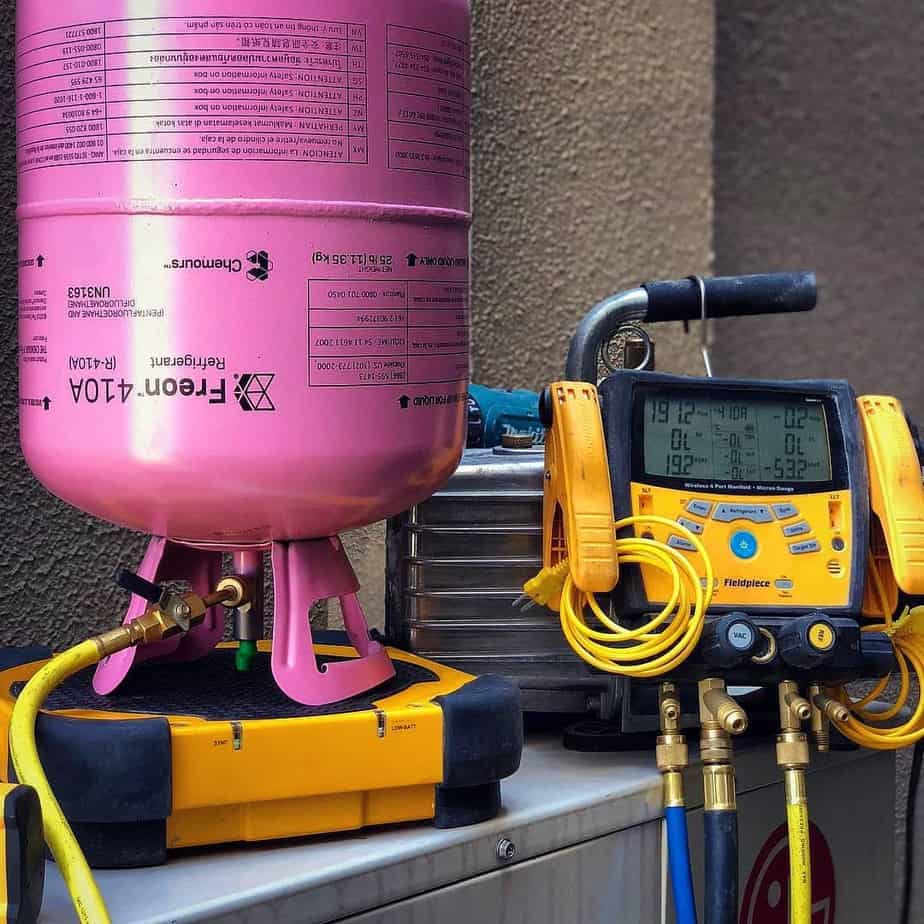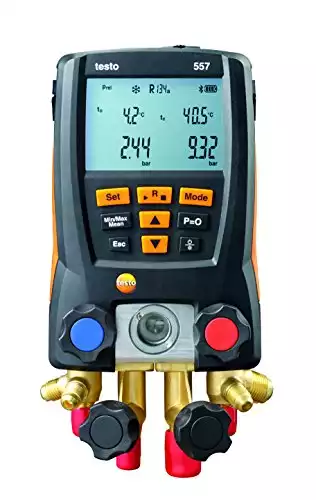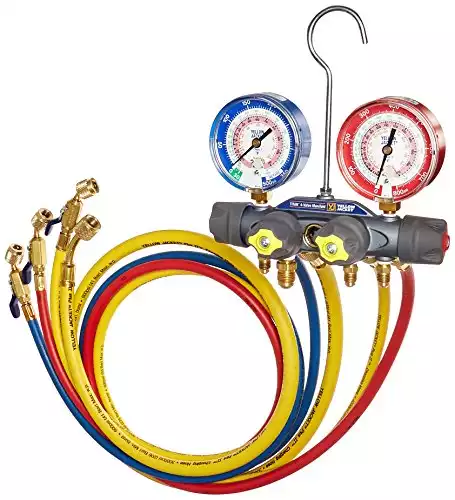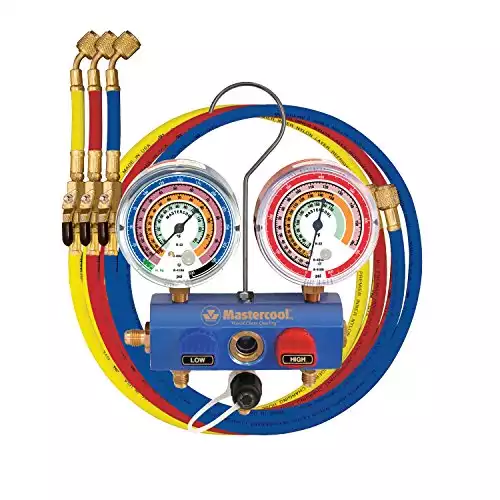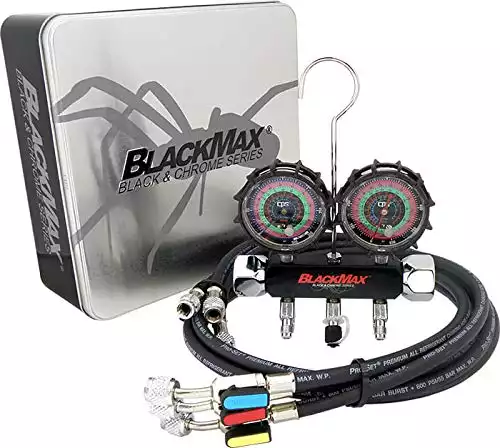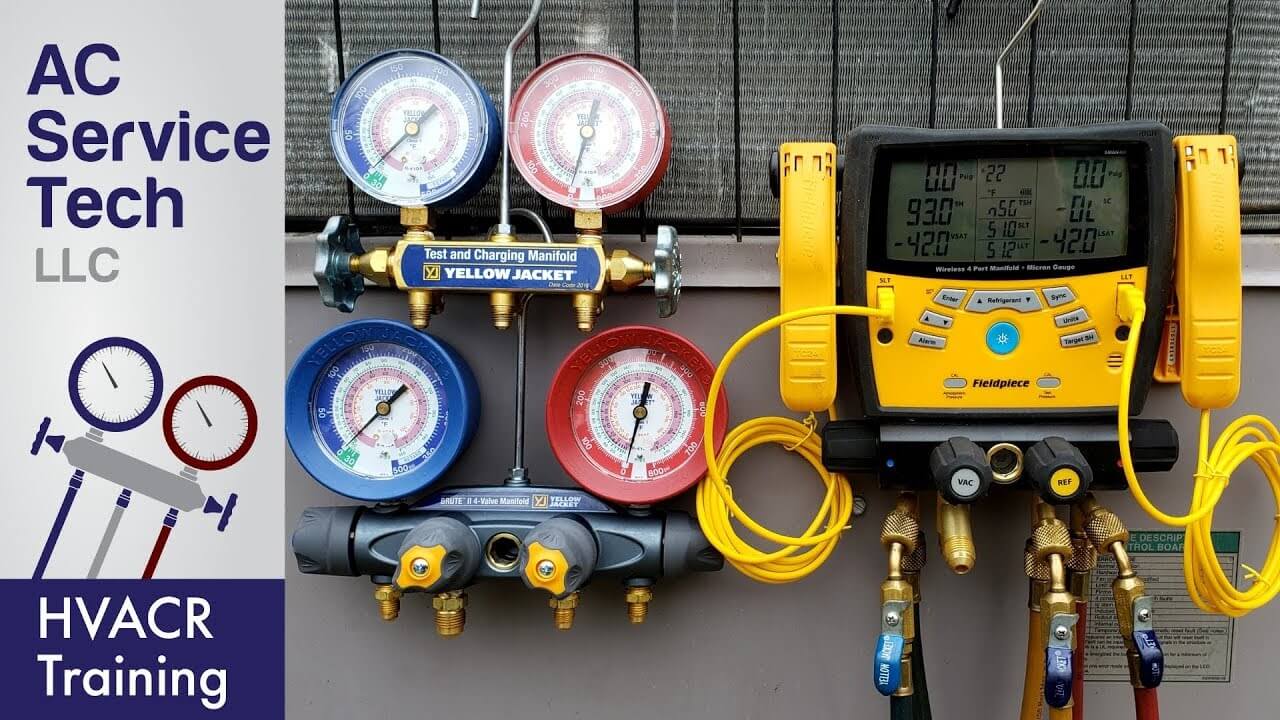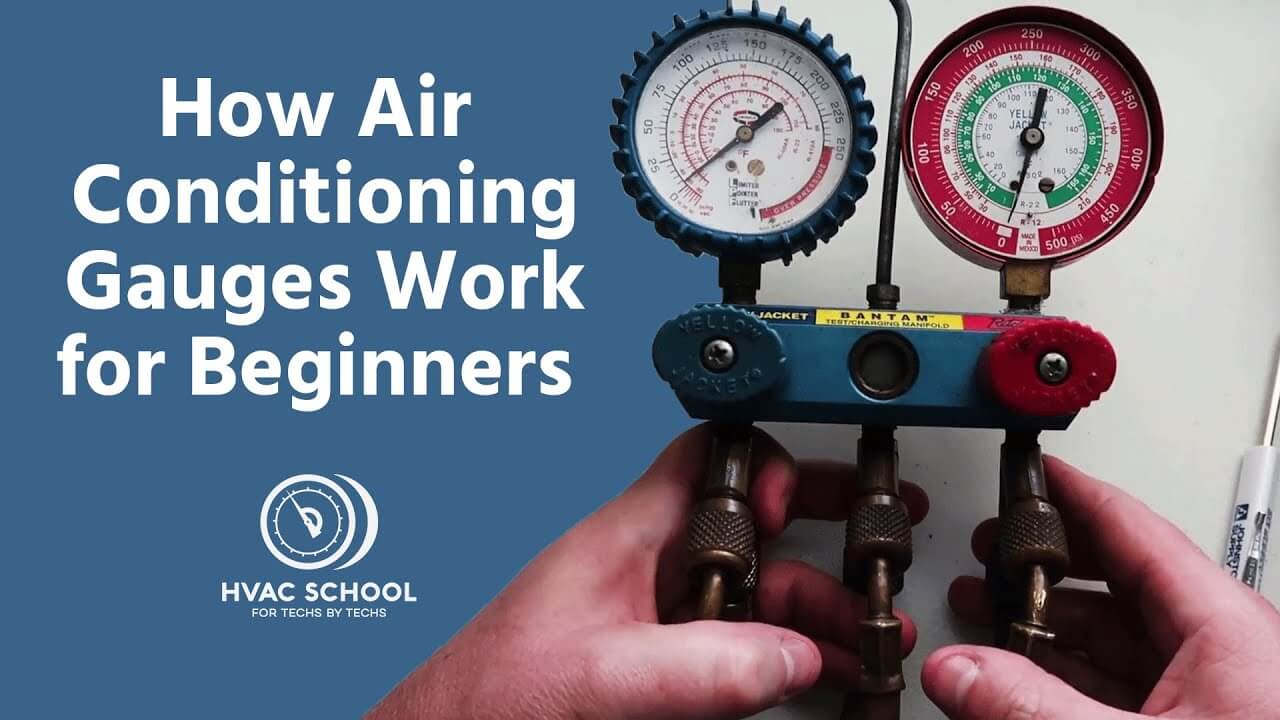Best HVAC Gauges for the Money
I decided to put the best HVAC gauges on the market to the test over the past 12 months.
And after tinkering around on several stinking hot roofs fitting and removing various analog and digital gauges, I came to the conclusion that sunscreen is an absolute must.
That said, I also learned that these are the 5 outright best HVAC gauges of 2022 so far. I’ve ranked them based on price, value, performance, and user experience.
So scroll a little further and feast your eyes on the one tool you gotta have as a HVAC technician to succeed.
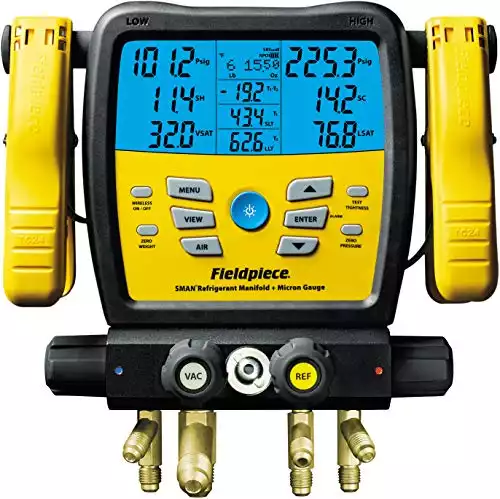 Fieldpiece SM480V SMAN Digital Manifold Gauges
Fieldpiece SM480V SMAN Digital Manifold Gauges
- Four-valve manifold set with precise micron gauge to accurately assess and repair any piece of HVAC equipment.
- Takes the guess the work out of the equation when conducting fault-find on refrigeration or air conditioning equipment.
- Data logging ability that allows you to stores up to 9 jobs internally so you can keep track of problem jobs.
- High-quality build with a rugged over-mold casing, reinforced hook, and hermetically sealed sight glass.
Comparison Chart
- Equipped with a micron gauge
- Versatile for 70+ refrigerant types
- Large, easy-to-read screen
- Highly precise gauge readings
- BlueTooth compatible data log
- Multipurpose 4-way manifold
- Great low-cost option for pros
- Durable manifold construction
- Durable high-quality nylon seats
- 3-1/8" silicone dampened gauges
- Sturdy aluminum and Lexan material
- Suitable for R410a, R22, and R404A
- Large aluminum Vortech valves
- Functional floating nylon sealing disk
- 15-micron certified vacuum rating
Best HVAC Gauges Reviews
We rounded up our top picks for the best HVAC manifold gauges. Learn about each device’s distinct features, and make sure you read up on the pros and cons before making a final decision.
1. Fieldpiece SM480V SMAN Digital Manifold Kit
The absolute best digital manifold set comes from Fieldpiece. The SM480V takes the guesswork and calculation out of HVAC work, and it comes with an impressive array of added features beyond dialing gauges.
This gauge is a reliable, durable option that will simplify your work through years of detailed HVAC servicing.
Product Highlights
Durability is crucial for a digital manifold, so the Fieldpiece is protected from all kinds of damage with a durable, water-resistant casing. This 4-valve manifold with a micron gauge comes with a 4-inch LED screen, which is bright and easy to read in both darkness and full sunlight.
The Fieldpiece SM480V boasts excellent accuracy, and as an added benefit, it remembers the refrigerant type and readouts from the last ten times you used it.
Navigating the gauge’s sophisticated features, like viewing reading history and calculating leakage, is not as difficult as you might think: the user-friendly interface mimics an analog gauge for people who are not used to reading off a screen.
It’s also worth noting the helpful micron alarm, which you can program to alert you with a beep when the vacuum reaches your desired level.
What We Like About the Fieldpiece SM480V SMAN Digital Manifold Kit
Perhaps the best feature of this digital manifold gauge set is its versatility. Fieldpiece claims that it can read over 70 different refrigerant types, including A2Ls and A3s. If this tool can relieve the need to carry around multiple gauges for different readings, then it’s well worth the investment.
It’s also a huge plus to be able to use this digital gauge if you’re used to looking at analog readouts. We like that you can get the accuracy of a digital manifold along with the durability and simplicity of a non-electronic unit.
What We Don’t Like About The Fieldpiece SM480V SMAN Digital Manifold Kit
While the Fieldpiece can be fitted to a wide variety of HVAC systems, you will have to buy separate hoses yourself, as the Fieldpiece does not come with any hoses in its kit. This can be an inconvenient downside.
Additionally, while the product does include a warranty, one of the downsides of Fieldpiece is that their customer service can be tricky to reach. When purchasing this durable machine, keep in mind that getting a refund for any faulty parts may prove difficult.
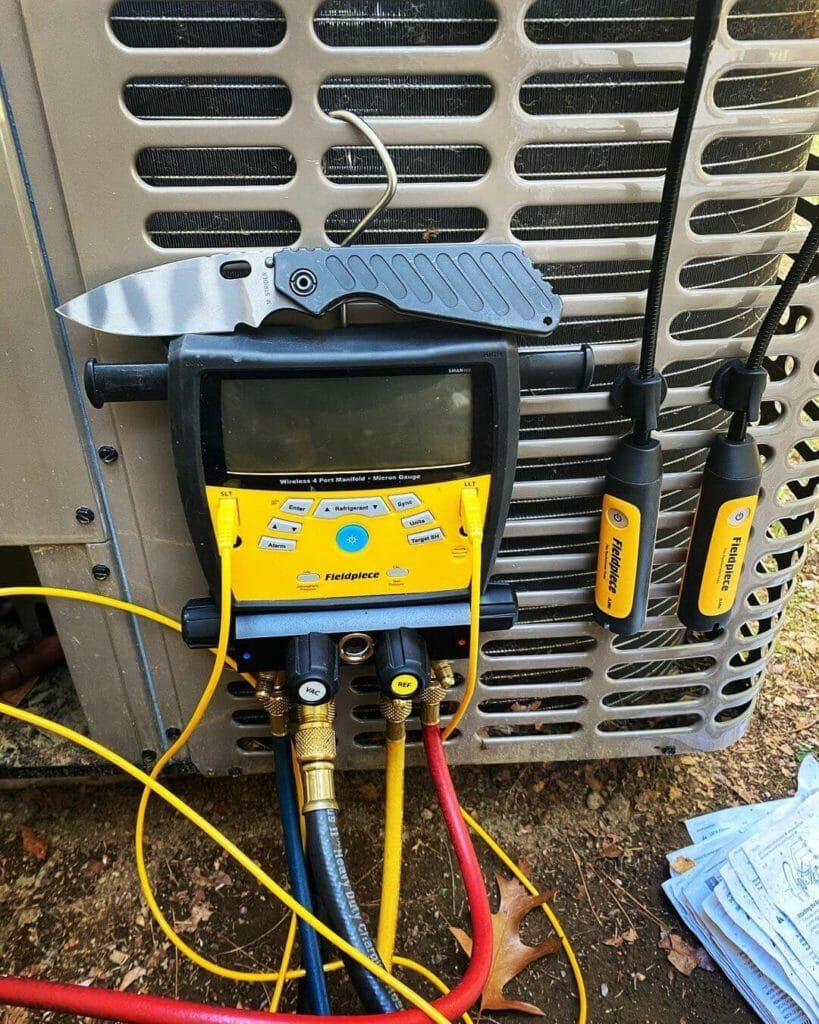
PROS
CONS
2. Testo 557 Digital Manifold Gauges
If you’re looking for a highly accurate and versatile set of digital manifolds, Testo’s 557 gauge set is our best digital pick.
Testo is a reputable German manufacturer that creates high-quality manifolds that adapt to a wide range of systems. The Testo 557 is easy to read and compact for when you need to test on the go.
Product Highlights
The Testo 557 AC gauge packs several handy features, making it one of the market’s best gauges. The 4-way manifold gauge set includes 3/8″ and 1/4″ valves for a convenient all-purpose hookup, with an automatic heat pump mode to save you even more time switching between hoses.
The digital gauges are color-coded with high and low-pressure sides and include an automatic calculation feature that works with both heating and cooling systems.
This HVAC gauge’s metal frame and ergonomic rubber cover combine comfort and durability for maximum long-term use. The backlit display shows precise, bright readings, and it even features BlueTooth capability if you’d rather see the low or high pressure reading on your smartphone.
What We Like About The Testo 557 Digital Manifold Gauges
The Testo is a complete kit with plenty of accessories, arriving with NTC temperature clamp probes, a vacuum probe, batteries, and a sturdy case. The Testo Refrigeration app adds plenty of convenience to taking readings and storing past data. It’s a big bonus that the kit comes with its calibration already certified, and ready to use.
As with any 4 way manifold gauge, it’s highly convenient to use a versatile tool like this for AC repair. You can use it with both heating and cooling systems, and it hooks up to a variety of hoses and designs, so you can treat this as an all-purpose tool that will add convenience to many different jobs.
What We Don’t Like About The Testo 557 Digital Manifold Gauges
Some Testo 557 gauges have issues with the vacuum probe. It’s a helpful added feature, but only if it works out of the box. You may also struggle to read the screen on the Testo in bright lighting situations, such as working on a rooftop.

PROS
CONS
3. Yellow Jacket 49968 Manifold Gauges
When it comes to finding the best HVAC manifold gauge, the Yellow Jacket 49968 is our first selection. Yellow Jacket has been a trusted USA-based manufacturer of AC gauges for years, and professionals and homeowners alike come back to the 49968 series. Quality craftsmanship and durable design make this one of the best gauges for a low price.
Product Highlights
The high-pressure hoses on the Yellow Jacket 49968 have the correct scaling for R-22, 410A, and 404A. The corresponding gauges are large and easy to use because they’re color-coded for high pressure and low pressure, and the analog gauges are simple and easy to read overall.
Durability is a strong selling point for these HVAC gauges. The manifolds come enclosed in a forged brass body that features polycarbonate crystals, ensuring you can keep using this tool through all kinds of wear and tear. It comes with double O-ring pistons and nylons seats for super heavy-duty use, along with a warranty on the manifold gauges and valves.
What We Like About The Yellow Jacket 49968 Manifold Gauges
For an analog gauge, this is a surprisingly user-friendly option. The Yellow Jacket is an excellent product for an entry-level HVAC contractor or first-time homeowner. The color-coding on the hoses and scales, along with the durable construction, make this a quality investment that should keep delivering excellent results for a long time.
Yellow Jacket also guarantees Class 1 Accuracy for this product. Class 1 refers to a 1% accuracy on its reading, so you can trust that you see an exact pressure measurement when you recharge your system. An accuracy guarantee is a significant bonus, considering many analog gauges have trouble in this department.
What We Don’t Like About The Yellow Jacket 49968 Manifold Gauge
The main downside to this product is that the sight glass is a little smaller than average. It can be tricky to read the position of the needle.
Disconnecting the hoses without blowback is also problematic because the manifold doesn’t come with low-loss hoses. If Yellow Jacket were to remedy these features, this would be a much more reliable option.
PROS
CONS
4. Mastercool 59661 Aluminum Manifold Gauges
If you’re still looking for the best analog gauge for your needs, the Mastercool 59661 gauge set is another top recommendation. This aluminum manifold gauge set is extra durable and arrives in a blow-molded carrying case.
For a dependable option that won’t mind being dropped or left in the basement for long stretches, the Mastercool 59661 delivers a comfortable reading experience on top of an elegant design.
Product Highlights
The sight glass included in the Mastercool manifold kit takes the headache out of reading the needle position. The gauges themselves come covered with durable Lexan lenses that complement the sturdy aluminum construction. You can measure pounds per square inch as well as Fahrenheit temperatures on this device.
The ergonomic handwheels on these gauges are contoured to fit your grip comfortably. The color-coding on the valves corresponds with brightly colored hoses, and the manufacturer has improved the face seal valves to lock in the refrigerant.
What We Like About the Mastercool 59661 Aluminum Manifold Gauges
The Mastercool 59661 are a sturdy set of gauges that come with a durable carrying case. With the double O-ring piston for added reliability, this is likely a manifold gauge set that will stand the test of time. The large gauge faces and sight class also mean it’s straightforward to use.
An aluminum gauge set is a dependable choice that won’t suffer from dings and bumps during travel from one site to another. We like that this comes with color-coded valves with a new and improved face seal to avoid leakage.
What We Don’t Like About the Mastercool 59661 Aluminum Manifold Gauges
While many parts of the Mastercool 59661 manifold are securely protected and lined for comfort, the manufacturer has neglected to add rubber fittings to the dials. The lack of protection and comfort for opening the valve is the main downside to this product.
PROS
CONS
5. CPS BlackMax MBH4P5EZ 2V Manifold Gauges
Finally, the CPS BlackMax wraps up our list of the best HVAC manifold gauge sets. CPS products describe their gauges as “by technicians, for technicians.”
They have a history of designing sensible products that counter the everyday problems of HVAC repair and maintenance. The BlackMax is a savvy analog manifold set that boasts patented special features with a rugged shell.
Product Highlights
The CPS BlackMax comes with a Triple-Seal Valve System that uses three Neoprene O-rings to minimize refrigerant release while using and disconnecting the manifold set. The floating nylon sealing disk further locks away contamination. It includes a large sight glass that makes reading its Vortech valves easy. Everything is housed in protective gauge boots and can be stored away in a protective tin.
Another remarkable feature of these HVAC manifold gauges is the Vortech Deep Vacuum Valve System, which certifies a 15-micron vacuum rating. Opening the dials lets the valve stems retract completely. The Teflon core allows the refrigerant to flow unrestricted with comfortable, light maneuvering as you adjust to the right pressure.
What We Like About the CPS BlackMax MBH4P5EZ 2V Manifold Gauges
Right away, the BlackMax arrives in a secure packaging that keeps its quality features safe. It has a lightweight design for how rugged the construction is, adding to the simplicity and convenience of using an analog manifold gauge set.
With the purchase of a Blackmax, you get a dependable, sturdy device with ball valves on the hoses that hook up without any blowback. The 15-micron vacuum rating is especially impressive, knowing you can get the fastest and most efficient refrigerant flow when using this manifold set for the job.
What We Don’t Like About the CPS BlackMax MBH4P5EZ 2V Manifold Gauges
For all the excellent patented materials that go into the BlackMax, it’s surprising to find plastic valves on the ends of the hoses. These are less durable than a standard metal valve and may wear out sooner. The rubber protectors on the gauges are also not as hardy as other parts of the manifold kit.
PROS
CONS
Best HVAC Gauges Buyer’s Guide
Not sure where to begin searching for the best device for you? Not all gauges are created equal, so here are the essential qualities you’ll find in the best HVAC manifold:
Compatibility with AC System
Of course, you’ll want to buy gauges for AC that are compatible with your system. Find out what type of refrigerant your home uses: if it’s R-22, your gauge set will need to read the lower pressures of this refrigerant. Many newer homes use R-410a refrigerant, so ensure your gauge is compatible with this scale before you buy.
If you’re an HVAC professional or expect to take readings of both refrigerant types, you’ll need a gauge with multiple readouts. The products we reviewed are compatible with both scales. Just make sure you flush your hoses and HVAC gauges before switching to a new refrigerant type, or else you’ll risk contaminating the next air conditioning with incompatible coolants.
Durability
The best HVAC gauge sets have metal parts. You’ll want a brass or aluminum tool with well-built features all around, including the hanger hook and connector fittings. The last thing you need is a cheap O-ring seal that degrades and renders the gauge useless. Everything should screw together tightly to avoid refrigerant leaks.
Look for water-resistant manifold gauges, especially if you’re choosing a digital option. Water-resistant is not the same as waterproof, but it’s an added layer of protection that many digital manufacturers offer.
A durable HVAC gauge should come with seal kits that you can use to change out O-rings yourself as they wear out. Remember that metal is prone to rust, so taking care of your gauge set and storing it in a protective case will extend its lifetime.
Gauge Type
There are three basic types of HVAC gauges, and you can read more detailed information about each one in the next section. It’s important to know what style you want, based on the kind of work you’re doing on a particular air conditioning system. Each type has its pros and cons, so review these carefully when choosing the best option.
Many experienced HVAC contractors carry an analog gauge because it doesn’t require a charge, although it can be challenging to read the needle and needs frequent calibration. Analog gauges are also an inexpensive choice if you’re sticking to a budget.
Other options include digital gauges, which can do some math for you and save historical readings. They will be more costly than analog options, and relying on digital tools makes you vulnerable to display errors and damage. If you’re used to an analog HVAC gauge, you may have trouble navigating the complex digital interface with its many features.
Lastly, a smartphone-compatible BlueTooth gauge set will communicate readings through your mobile device or tablet. These are typically the most expensive of the three options, but the convenience is worth it for many users.
Display Quality
An easy-to-read HVAC gauge is the best tool you can carry as a contractor or homeowner. It’s essential to have a gauge that doesn’t scratch or shatter easily. The display should come covered by either strong plastic or glass, which have different pros and cons.
Glass is more scratch-resistant and transparent for readings in direct sunlight, but it’s also more prone to shattering. Plastic will scuff and scratch but never break, and it may be easier to replace with an inexpensive new cover.
If you’re shopping for a digital gauge, look for an LED screen that will be visible in all lighting conditions, from full rooftop sun to a dark basement. For an analog gauge, the best options come with a sight glass that makes the needle’s position easier to pinpoint.
Accuracy
The best manifold gauges will come pre-calibrated because it’s essential to get an accurate reading. It’s important to consider whether you can calibrate the gauge set yourself because even the highest quality gauge will need an occasional tune-up.
If you need it calibrated by a professional, factor in the price and time these occasional trips will run you.
User-Friendliness
The best HVAC gauges are easy to use, saving you time and frustration. Color-coded readings help you easily distinguish the low-pressure and high-pressure valves and their corresponding tubes. It helps to look for gauges with ergonomic handles so you can comfortably take measurements and avoid dropping and damaging the tools.
It’s also critical to find gauges with valves that quickly and tightly seal to hoses so that you aren’t stuck fiddling with your equipment while you leak refrigerant.
As we’ve mentioned before, digital gauges tend to be less user-friendly than analog, simply because they come with so many added features. These additional services can benefit a seasoned HVAC professional. Still, for a beginner, it can be overwhelming to navigate a digital manifold set.
Special Features
Some HVAC gauges include extra features that may be worth additional investment. Carrying cases and hoses come with the most high-quality gauges, but you may prefer a manifold gauge set that includes a sight glass for easier reading. Other notable features may consist of anti-blowback hoses and can taps. Some digital gauges will even do the math for you to determine subcooling or superheating levels.
It’s helpful to note how many adaptors come with the gauge. If you expect to work with both high and low-pressure systems, you’ll need a gauge set that is either fitted for different refrigerants or easily adapted to the unit you need.
Price & Warranty
Lastly, your budget is an essential factor in choosing the best manifold gauge set for you. Some of the gauges we’ve reviewed will suit all budget levels, but others will be more of an investment. A higher price often reflects added features that come with the gauge.
If you’re thinking about buying a more costly gauge, take the warranty into account. Some manufacturers offer warranties on certain parts, while others will cover the entire set. Other manufacturers might have certain conditions under which they’ll cover a set of AC gauges. Be sure you understand the terms of the warranty before you buy.
Types of HVAC Gauges
There are three basic types of HVAC gauges. The best option for you depends on your design preferences, whether you’re an experienced or entry-level contractor, and what kind of HVAC systems you will be maintaining. Here are the essential features of each type:
Analog
For most of history, all gauges were analog. The traditional choice remains a favorite for many HVAC professionals, who say you can’t beat the reliability of an analog HVAC gauge. They’re less vulnerable to damage and display errors than a digital option, and they tend to hold accuracy for much longer after being calibrated.
Analog gauges read your air conditioning unit using a needle that moves with changing pressure. You can manually calibrate these gauges by adjusting screws underneath the protective cover until the needle points to zero.
For contractors or homeowners on a tight budget, analog HVAC gauges are the least expensive option. They’re easy to read, calibrated, and ready to work out of the box, and reliable enough that you can expect them to take an accurate reading after they’ve sat in the garage for a long time.
Digital
With a digital gauge set, you’ll see your reading on an LCD or LED screen. Digital gauges are easy to read, especially in dim conditions, but manufacturers tend to pack on many confusing features that overwhelm a beginner.
Digital manifold gauges are not as reliable as analog because they’re battery-powered, so you’ll have to wait for dead gauges to charge before using them. They’re also useless if the display malfunctions, so accidentally dropping your digital gauge or spilling water on it could mean game over.
However, a digital gauge can often pick up a far more accurate number than the ballpark pressure reading you get from an analog gauge. For this, along with the multitude of other features that digital gauge manufacturers can pack into these tools, they are a popular choice.
BlueTooth
The most tech-advanced option on the market, BlueTooth gauges, are rising in popularity for their convenience. The ability to sync readings with a smartphone app can help streamline the process and recording data.
However, like the digital gauge, a BlueTooth gauge is prone to tech failures. Beyond just relying on the gauge itself, you depend on your smartphone and app functioning correctly to get an accurate reading, not to mention the wireless connectivity working. For this reason, many experienced HVAC workers carry a backup analog gauge in case the BlueTooth fails.
Best HVAC Gauges FAQ.
Are you still wondering how the best gauge sets work? Here are the most common questions about HVAC manifolds along with our expert answers.
Why Use an HVAC Gauge?
Whether you’re an HVAC professional or a homeowner repairing your first air conditioner, an HVAC gauge is an essential tool for the job. They come in digital and analog form, with a range of price options, so it’s worth picking one up even if you don’t plan to use it regularly.
An HVAC gauge will give you readings about static pressure and load pressure within an air conditioning system. You can use the gauge to refill your system with refrigerant, and it will also warn you about an over-filled system.
You can even locate clogs or leaks in your refrigerant piping using this helpful tool. It’s a money-saving device that keeps your heating and cooling healthy, whether you’re a homeowner or a contractor.
HVAC professionals can work more efficiently using an HVAC manifold gauge to diagnose problems with a client’s heating and cooling system. If you’re hiring a contractor to work on your HVAC problems, you can use a gauge ahead of time to avoid overpaying for services you don’t need.
How to Use HVAC Manifold Gauges Like a Complete Pro
If you’re using an analog gauge, make sure you’ve calibrated it before you begin. The needle should point to zero before the gauge is connected. If it isn’t at zero, you’ll have to adjust the calibration screws found underneath the protective glass or plastic on most manifold sets. Once you get a completely neutral reading, you can proceed to the next step.
You’ll then remove the cap from the screw-on nozzles and attach the hose ends to your gauge. Most hoses are color-coded, with red for high-pressure and blue for low-pressure so that you can connect them to the correct colored ports on your manifold gauge. The high-pressure hose will also have a smaller copper tube.
At this stage, you should ensure you have the correct hoses or adapters for the refrigerant type you’re working with and ensure you have a strong seal. Otherwise, coolant could be released into the atmosphere when you open the valve, which is illegal.
Next, you’ll attach the center hose to the refrigerant tank. At this point, check that you’ve sealed everything tightly and you’re ready to open the valves. Twisting the dials will adjust how much coolant is going into the tank, and you can open and close to change the speed at which the refrigerant flows.
As you open the valves, you’ll see some fluctuation in the gauge needle (or display numbers if you’re using a digital gauge.) Now is an excellent time to pause and allow the reading to level out; then, you can continue opening the valve to ensure your assessment is accurate. Wait for the needle or digital gauge to reach the desired level, then close the valve.
How to Effectively Disconnect Gauges from a System with Minimal Refrigerant Loss
When you’ve finished the job, and it’s time to disconnect your manifold gauge set from the system, make sure you follow the steps carefully to avoid releasing wasted refrigerant into the atmosphere.
First, ensure all valves on the manifold are closed. The goal is to avoid blowback, which is refrigerant puffing out of the valve cores as you unscrew the hoses. This situation is where an anti-blowback hose can come in handy.
If you don’t have anti-blowback hoses, it’s up to you to unscrew the ends as quickly as possible to minimize the amount of coolant that blows out. Once they’re off, securely tighten the valve caps onto each pressure line.
If you’re planning on using your HVAC gauge on another system, remember to purge your hoses with nitrogen once you’re finished. Otherwise, the leftover refrigerant could contaminate the next air conditioning system you service. Safely store your HVAC manifold gauges in a carrying case, and you’re ready for the next project.
What Should HVAC Gauges Read?
The ideal reading on each HVAC gauge will depend on the weather, temperature, and refrigerant type. There is no single answer for what a manifold gauge set should read because each system’s factors are different.
For an R-22 air conditioning system, you should expect low pressure to be around 30-40 if the ambient temperature is 90 degrees Fahrenheit.
Can I Use the Same Gauges for R22 and R410a?
In short, you can use the same gauges for R22 and R410A, as long as you have the correct hoses and properly purge them before switching. These are both common types of refrigerants, but they are not compatible between systems, so it’s essential to avoid contaminating an air conditioning unit that uses R22 with hoses that still contain traces of R410A coolant.
Can You Use R134a Gauges on R410a?
You can use the same HVAC manifold gauge for both R134A and R410A. As long as your gauge is the correct scale and pressure capability for both systems, you can flush out your hose to avoid cross-contamination and connect it to the other network.
The best way to ensure your gauge will be compatible with different refrigerants is to buy a 4-way model. You may even want to look for HVAC manifold gauge sets that come with several extra adapters for maximum compatibility.
Digital HVAC Gauges vs. Analog HVAC Gauges
As we’ve touched on previously, there are ups and downs to using digital HVAC gauges vs. analog gauges. The main difference is that an analog gauge uses a calibrated needle to check the pressure, while a digital gauge shows a battery-powered display.
Digital Gauge Benefits:
Analog Gauge Benefits:
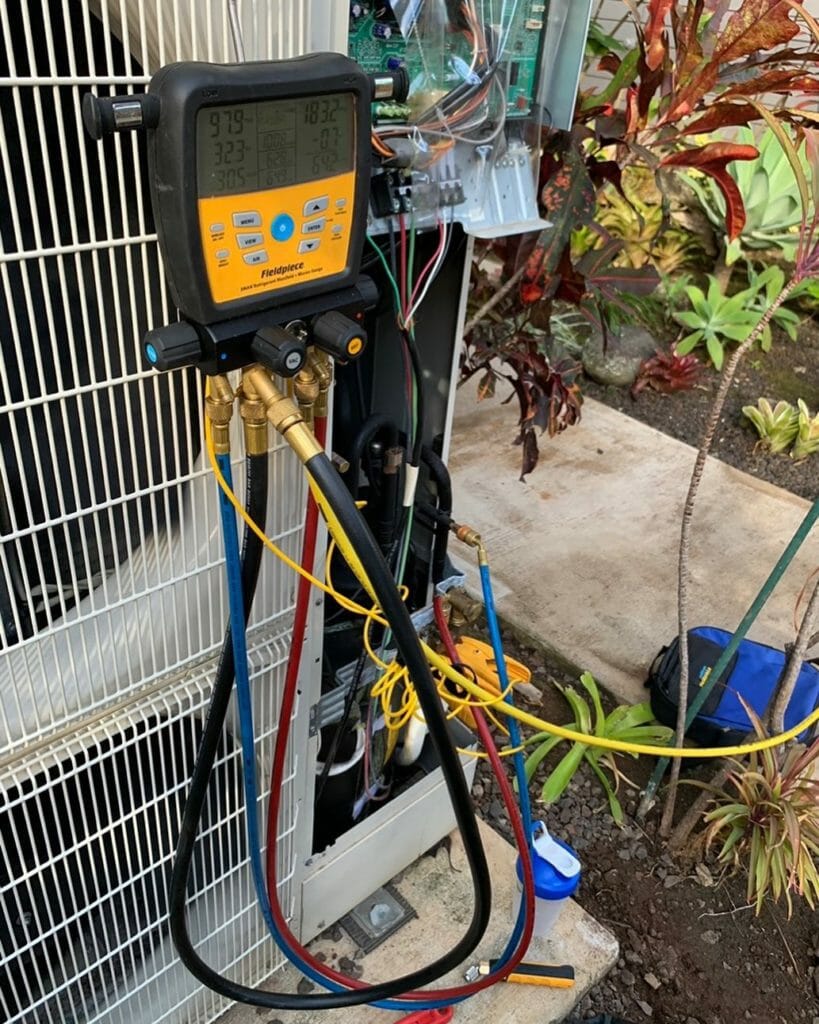
Common HVAC Gauge Issues & Solutions
It can be stressful to notice that something is wrong with your manifold set, but luckily most issues with the gauge set itself are easy to diagnose and fix. It’s likely that if the reading seems off, the error is actually with the air conditioner, which can be a larger problem.
Here are the most common problems that come up when using an HVAC gauge, along with our recommendations for quick fixes. Follow these helpful tips and rule out gauge issues before you call for HVAC repair:
- The needle isn’t moving.
There are three typical reasons for this. It’s most likely that you forgot to open your valves or you have the condenser turned off. Rarely, the air conditioner may be entirely out of refrigerant. Thankfully, all three explanations have quick fixes.
- Valves are stuck.
If you can’t turn the valves to open or close them, this indicates a troubling problem with the inside of your gauge. The internal valve controls may have stripped, which you can fix by opening up the device or ordering a replacement valve. It’s helpful to get a warranty that covers faulty valves when this situation arises.
- Hose ends are hissing.
Hissing sounds are a bad sign that you are leaking refrigerant. Immediately shut off the valves and disconnect the hoses completely. It’s likely that you need to seal the hoses more tightly or that they were cross-threaded. Reattaching should solve the issue; otherwise, it may be time to order a new hose.
- The needle doesn’t go to zero after the hoses are disconnected.
A needle may not reach zero when there is leftover refrigerant in the hoses. After you’ve removed the hoses from the air conditioning unit, detach them from the manifold itself. You should now see the needle returning to zero. If not, it may be time to calibrate the gauge.
FINAL VERDICT
We rounded up the top HVAC gauge products on the market to highlight the best quality and most durable options. Out of these choices, the Fieldpiece SM480V is the clear winner. With the Fieldpiece, you get one of the most rugged digital manifolds money can buy, and you’ll enjoy added features that take the guesswork out of testing your HVAC system.
Many different factors go into choosing the best digital manifold gauge set or analog gauges for you. While some HVAC professionals or DIY homeowners might prefer an analog method, the Fieldpiece delivers the most accurate reading for over 70 types of refrigerant. There’s no way you can get a better bang for your buck than this versatile option.
From the micron alarm feature to the last ten readings stored in the Fieldpiece’s memory, the helpful features Fieldpiece packs into this device make it stand out as the best choice.
In Conclusion
HVAC maintenance isn’t as difficult as many people think. As long as you have a reliable, durable, accurate set of gauges to help you out, you can get your HVAC system under control.
Luckily, finding the best HVAC manifold gauge on the market has never been easier. Whether you’re working with low-pressure or high-pressure systems, looking for a micron gauge, or just hoping to get a device that gauges AC pressure without the bells and whistles, we reviewed the top HVAC manifold gauges so you can get the best bang for your buck.
Our buyer’s guide will help you avoid the pitfalls of cheap, easily breakable tools so you can minimize frustration and focus on the task at hand.
If your old manifold gauges need an upgrade, the Fieldpiece SM480V is our top recommendation. They perform head-and-shoulders above the competition. Whatever you choose, you deserve a device that’s helpful, accurate, and will stand the test of time.

